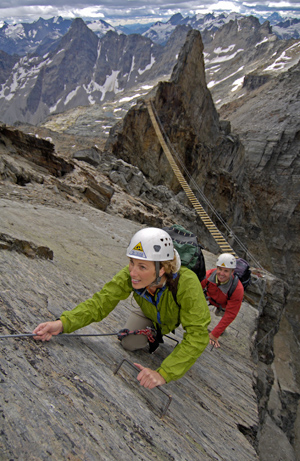
Originally Topher Donahue on Tue, Jun 29, 2010.
I visited the CMH Bobbie Burns Lodge in the summer of 2007 as the guides were putting the finishing touches on the now legendary Mt. Nimbus Via Ferrata. Traversing the knife-edged ridges, straddling the tiny summits, and walking across the airy suspension bridge was exciting enough while tethered into a bombproof harness and cable. Building the thing must have been outrageous. To find out a bit more about the installation and its strength, I tracked down Carl Trescher, a British Columbia native and mountain guide. After experimenting with a small via ferrata on Mt. Syphax, Trescher went to Europe, the birthplace of adrenaline sport, to learn from the masters.
TD: What kind of training did you do in Europe?
CT: I did a High Ropes Instructor Course. I concentrated mainly on the building aspects of the course and learned lots of different techniques for setting up ziplines, portable and permanent cable structures and protection systems as well as specific rescue techniques with cable based systems.
TD: The forces on the suspension bridge must be massive. Do you have any idea how much force is placed on the anchors if a person is standing in the middle of the bridge?
CT: Surprisingly, the forces placed on the anchor system of the suspension bridge are pretty low. Safety is by far our main priority. We distribute the load between 4 main cables, which then distribute the loads to their separate anchor systems. A separate safety cable and anchor system is used for fall protection. We use a dynamometer to measure the force on most of our structures and maintain a safety ratio of around 10:1 or greater. Measuring the force on the bridge anchors comes in under 2 kilonewtons (the force of about 204kg) with someone standing in the middle.
TD: 10 times stronger than needed! That’s nice to know. So how strong is that?
CT: We use expansion bolts to build our anchoring systems for the bridge. These systems are theoretically capable of holding around 100 to 135 Kilonewtons. (The force of over 13,000kg.) Should be strong enough!!!
TD: How long did it take to install?
CT: The Mt. Nimbus Via Ferrata was built in a series of phases of two summer seasons. About three weeks of construction time was taken to complete each phase. The material required to build a via ferrata a sure weighs a lot and some days it sure felt a lot longer!!
TD: How do average people do on Mt. Nimbus in terms of both fear and physical difficulty?
CT: The average person and first timer does incredibly well on the via ferrata. The great thing about it is you are going to some outrageously wild places and situations in the mountains, yet it is completely safe and not difficult so the average person is more than able to physically do it.
Most people do quite well with the fear also. We designed the via ferrata with a bit of flow starting off with easier sections and slowly building as we climb Nimbus Tower. For those looking for a bit of adventure this is definitely the highlight of the trip. We try to get to know people on the first hiking day as a lot of people are physically able to do the ferrata although not every person would necessarily enjoy it. That is one of the great things though about summer in the Bobbie Burns as there is still all the great hiking and classic mountaineering as well as the adventure trails and via ferratas.
Have you done the Mt. Nimbus Via Ferrata? Did it feel strong enough to you?
Mt. Nimbus Via Ferrata photo by Topher Donahue